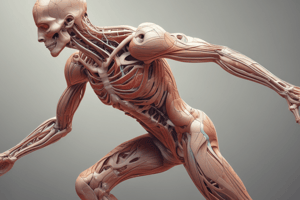Podcast
Questions and Answers
In joint movement, what happens to the convex joint surface when the body segment's motion is upward?
In joint movement, what happens to the convex joint surface when the body segment's motion is upward?
- It moves in the same direction as the body segment
- It rotates down (correct)
- It remains stationary
- It rotates up
What does the cupped right hand represent in the joint demonstration?
What does the cupped right hand represent in the joint demonstration?
- Concave surface of one bone
- Convex joint surface of one bone
- Convex joint surface of the other bone
- Concave surface of the other bone (correct)
When raising the left elbow, how does the cupped right hand move in relation to the left fist?
When raising the left elbow, how does the cupped right hand move in relation to the left fist?
- Remains at the same level as the left fist
- Moves up and over the left fist (correct)
- Rotates around the left fist
- Moves down and under the left fist
What happens to the left fist when the left forearm moves up during the joint demonstration?
What happens to the left fist when the left forearm moves up during the joint demonstration?
Which type of joint surface will move on a fixed concave surface in the opposite direction as the moving body segment?
Which type of joint surface will move on a fixed concave surface in the opposite direction as the moving body segment?
During finger extension, which joint surface moves in the same direction as the phalanx itself while moving on the convex metacarpal joint surface?
During finger extension, which joint surface moves in the same direction as the phalanx itself while moving on the convex metacarpal joint surface?
What type of joint surface moves on a fixed convex surface in the same direction the body segment is moving?
What type of joint surface moves on a fixed convex surface in the same direction the body segment is moving?
Which bone end shape requires joint surfaces to move in a specific way during joint movement?
Which bone end shape requires joint surfaces to move in a specific way during joint movement?
What is the movement direction of a convex joint surface on a fixed concave surface during shoulder flexion?
What is the movement direction of a convex joint surface on a fixed concave surface during shoulder flexion?
What determines how joint surfaces need to move during joint movement?
What determines how joint surfaces need to move during joint movement?
Flashcards
Convex Joint Surface Movement
Convex Joint Surface Movement
In joint movement, the convex joint surface rotates down when the body segment's motion is upward.
Cupped Hand Representation
Cupped Hand Representation
In a joint demonstration, the cupped hand represents the concave surface of a bone.
Elbow Raising Demonstration
Elbow Raising Demonstration
When raising the left elbow, the cupped right hand moves up and over the left fist in the joint demonstration.
Forearm Movement and Fist Rotation
Forearm Movement and Fist Rotation
Signup and view all the flashcards
Movement on Fixed Concave Surface
Movement on Fixed Concave Surface
Signup and view all the flashcards
Finger Extension Movement
Finger Extension Movement
Signup and view all the flashcards
Movement on Fixed Convex Surface
Movement on Fixed Convex Surface
Signup and view all the flashcards
Concave Bone End Requirement
Concave Bone End Requirement
Signup and view all the flashcards
Shoulder Flexion Movement
Shoulder Flexion Movement
Signup and view all the flashcards
Joint Movement Determinant
Joint Movement Determinant
Signup and view all the flashcards
Study Notes
Joint Movement
- When the body segment moves upward, the convex joint surface moves downward.
- The cupped right hand in the joint demonstration represents the concave joint surface.
- When raising the left elbow, the cupped right hand moves downward in relation to the left fist.
- When the left forearm moves up during the joint demonstration, the left fist moves upward.
- A concave joint surface will move in the opposite direction as the moving body segment on a fixed convex surface.
- During finger extension, the concave joint surface of the phalanx moves in the same direction as the phalanx itself while moving on the convex metacarpal joint surface.
- A concave joint surface moves on a fixed convex surface in the same direction the body segment is moving.
- The bone end shape that requires joint surfaces to move in a specific way during joint movement is the convex-concave joint surface.
- During shoulder flexion, the convex joint surface moves upward on a fixed concave surface.
- The bone end shape determines how joint surfaces need to move during joint movement.
Studying That Suits You
Use AI to generate personalized quizzes and flashcards to suit your learning preferences.




